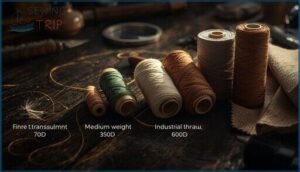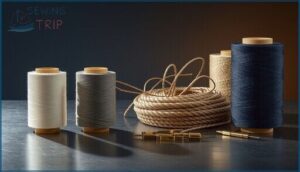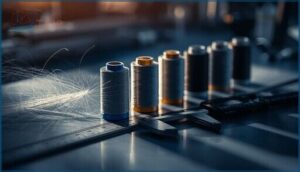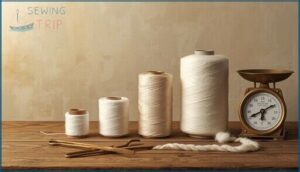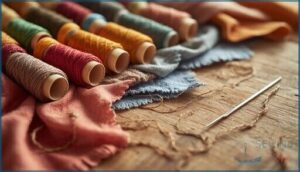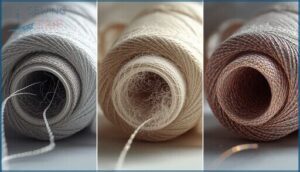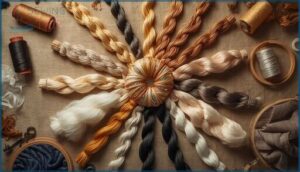This site is supported by our readers. We may earn a commission, at no cost to you, if you purchase through links.
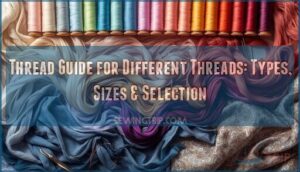
You’ve seen it happen—your stitches pucker on delicate silk, your heavy-duty repairs snap under tension, or that vibrant decorative topstitching fades after a single wash. The culprit isn’t your technique or your machine. It’s the thread.
Matching thread to fabric isn’t just about picking a color that looks close enough; it’s about understanding how polyester’s durability differs from cotton’s breathability, why rayon shines but struggles with stress, and how thread weight affects everything from needle size to seam strength.
Once you know which thread is suited to which purpose, you’ll avoid costly mistakes and achieve professional results on every project you tackle.
Table Of Contents
Key Takeaways
- Matching thread fiber content to fabric composition reduces seam distortion by roughly 30% and prevents common failures like puckering, slippage, and premature breakage under stress.
- Thread weight directly determines the appropriate needle size—your needle’s eye must be about 40% larger than the thread diameter to prevent tension issues and maintain consistent stitch quality.
- Polyester thread outperforms cotton in durability with 15-25% elongation, tensile strength up to 19 pounds-force, and superior heat resistance reaching 260°C, making it ideal for synthetic fabrics and high-stress applications.
- Specialty threads like metallic, glow-in-the-dark, and wash-away options expand creative possibilities, but each requires specific needle sizes, tension adjustments, and slower stitching speeds to prevent breakage.
Thread Types Explained
Every sewing project starts with choosing the right thread, and understanding the different types available makes that choice much easier.
Each thread type has unique properties that affect how it performs with various fabrics and techniques.
Let’s walk through the main thread options you’ll encounter, so you can match the right thread to your next project.
General Purpose Thread
General purpose thread doesn’t just work—it excels across nearly every sewing challenge you’ll face. This polyester composition powerhouse accounts for roughly 60–70% of retail sales because it genuinely delivers. You’re getting a core-spun structure that combines continuous filament strength with a wrapped sheath, achieving thread elongation around 15–25% before breaking. That flexibility matters when fabric stretches or seams face stress.
Most general purpose options fall within Tex ranges of 18–27, perfectly suited for medium-weight garments and everyday projects. For securing fabric edges, consider using strong serger threads.
Here’s why sewers trust it:
- Withstands machine speeds up to 1,000 stitches per minute without heat buildup
- Offers 100–400 color shades for precise matching
- Works seamlessly with woven and knit fabrics
- Provides greater durability compared to cotton alternatives
- Eliminates the need for multiple specialty thread types in your collection
Polyester Thread
Polyester thread stands out for its remarkable polyester durability and heat resistance, withstanding needle temperatures up to 260°C during high-speed sewing. Its UV stability keeps outdoor seams strong and vibrant longer than most alternatives.
Industrial uses include bag closing, where heavy-duty constructions reach tensile strengths of 17–19 pounds-force. Thread finishes like heat-setting reduce shrinkage below 1%, preventing puckering after washing. For enhanced strength, consider using bonded polyester thread in upholstery applications.
When making thread selection decisions, consider fabric compatibility. Polyester’s low moisture regain and stable thread properties make it your go-to for synthetic blends and garments requiring long-lasting performance.
Cotton Thread
Cotton thread, produced from staple fibers, features low extensibility, making it ideal for stable woven fabrics rather than stretchy knits. Mercerized cotton enhances luster and color saturation, giving your seams a polished look.
Its thermal behavior differs from synthetics—cotton won’t melt under typical ironing temperatures, preventing fused seams. However, cotton durability suffers in high-friction garment applications compared to polyester.
For fiber compatibility with natural textiles and quilting, cotton thread remains your traditional choice despite lower abrasion resistance.
Quilting Thread
When you need extra strength for hand quilting, thread glazing makes all the difference. This specialized coating smooths the fiber surface, letting you pull stitches through multiple layers without friction buildup.
Quilting weight cotton thread—usually heavier than standard polyester thread—works beautifully for button attachment and decorative topstitching.
Your thread selection depends on project demands: choose glazed cotton for traditional quilting or opt for polyester thread when durability matters most.
Silk Thread
For heirloom projects and couture work, silk thread delivers unparalleled luxury. It’s produced from continuous silkworm filaments that create exceptionally fine threads with surprising tensile strength. Weights comparable to 60wt to 100wt are ideal for delicate fabrics like chiffon and silk, where reduced diameter minimizes seam visibility.
Silk properties include natural flexibility and a smooth surface that glides through densely woven textiles with minimal needle drag. This thread fineness, combined with color vibrancy and lustrous shine, makes it perfect for embroidery and fine tailoring.
Just remember that quality silk costs more than polyester or cotton equivalents.
Rayon Thread
When you want embroidery that pops with striking luster, rayon thread delivers unparalleled shine and vibrant colors. Its smooth texture glides effortlessly through fabric, making it ideal for decorative stitching on garments and home décor.
However, rayon durability falls short of polyester alternatives—it weakens when wet and lacks abrasion resistance for high-wear items. Consider rayon limitations before choosing it, and explore specialty threads or embroidery threads with better longevity for projects requiring frequent washing.
Linen Thread
For projects demanding true grit, linen thread remains unparalleled among natural fibers. Its friction-resistant structure excels in heavy-duty applications—bag straps, leather goods, and button attachments—where synthetic threads might slip or degrade.
Consider linen properties when evaluating fabric compatibility:
- Natural Strength: Linen durability outperforms cotton in high-stress seams
- Historical Uses: Weaving and bookbinding relied on linen’s longevity for centuries
- Thread Fiber Content: Pure flax fibers resist abrasion better than blended alternatives
- Limited Color Range: Sewing linen offers fewer dye options than polyester
- Linen Alternatives: Modern synthetics match strength but lack natural breathability
While thread durability matters most in demanding work, linen’s natural resilience makes it irreplaceable where authenticity meets performance.
Extra-Strong Thread
When standard polyester can’t handle the job, extra-strong thread steps in with serious muscle. Heavy-duty formulations using high-tenacity nylon or polyester deliver tensile strengths exceeding 11 pounds-force, making them ideal for industrial sewing applications like upholstery, outdoor gear, and bag construction.
Thread durability matters most when stress tests your seams:
| Thread Material | Strength Testing | Industrial Uses |
|---|---|---|
| High-tenacity nylon | ~11.3 lbs breaking force | Backpacks, harnesses |
| Polyester multi-ply | 17–19 lbs tensile strength | Bulk bags, packaging |
| Kevlar aramid | Highest available strength | Protective gear, specialized equipment |
| Standard polyester | 1,000–2,000 centinewtons | General apparel |
| Cotton staple | Lower extensibility | Woven fabric seams |
Keep in mind that heavy-duty threads require industrial sewing machines and larger needles—usually commercial size 69 or heavier—to maintain stitch quality without jamming your equipment.
Thread Size Measurement
Understanding thread size isn’t as simple as picking small, medium, or large off a shelf. Different measurement systems exist because the textile industry developed standards across various regions and applications, each with its own logic.
Let’s break down the four main systems you’ll encounter so you can decode those labels and choose the right thread for your project.
Denier System
The Denier System measures thread weight as grams per 9,000 meters—a straightforward way to compare thread size across applications. Size conversion is simple: divide 9,000 by denier to get approximate thread weight. This measurement directly impacts thread properties like bulk and tensile strength, making denier essential for informed thread selection.
You’ll find lower denier counts like 70D perfect for delicate fly tying on small hooks, while 350D accommodates your everyday sewing projects. When you need industrial usage for canvas or outdoor gear, 600D or higher delivers the thread strength required.
Tex System
Tex calculation gives you the weight in grams of 1,000 meters of thread—higher Tex numbers mean heavier, thicker thread. This ISO standardization makes sewing thread selection straightforward: Tex 25 weighs 25 grams per 1,000 meters, while Tex 70 suits heavy-duty work.
For Denier conversion, multiply Tex by nine. Industrial adoption is widespread because labeling guidance is consistent, and thread properties become instantly comparable.
You’ll find Tex values ranging from 10 for fine embroidery to 138+ for canvas and marine fabrics.
Metric Count System
You’ll find Metric Count (Nm) works opposite to Tex—higher numbers mean thinner thread since it measures how many kilometers weigh one kilogram. When you see Nm 60/2, that’s a two-ply thread where each strand has a count of 60.
For Tex conversion, just divide 1000 by the Nm value. This ISO-standard system helps you nail thread fineness for precise thread selection in industrial applications.
Cotton Count System
Cotton Count (Ne) flips the script on thread measurement—it tells you how many 840-yard lengths fit into one pound of yarn. When you see Ne 10, that means ten hanks weigh exactly one pound. Historical roots trace back to 1726 English textile mills, and today ISO Standards formalize this indirect numbering system where higher counts signal finer threads.
Key advantages for thread selection:
- Calculation methods use simple division: total yards divided by weight in pounds, then divided by 840
- Yarn fineness scales intuitively—Ne 60 produces lighter fabric than Ne 30
- Thread fiber types like cotton, rayon, and worsted adapt this system for consistent industrial weaving
Choosing Right Thread
Choosing the right thread isn’t about guesswork—it’s about matching your materials to get clean, lasting results. Your fabric type, thread content, weight, and needle size all work together like pieces of a puzzle.
Here’s what you need to think about to make the right choice every time.
Fabric Type Consideration
When fabric weight ranges from 30 to 300+ GSM, you’ll quickly discover that choosing thread becomes less about guesswork and more about matching structural properties. Woven fabrics like denim and twill demand threads with higher tensile strength because their stable construction endures significant seam stress during wear.
Knit fabrics, on the other hand, stretch 25–50% along at least one direction, so you need polyester or corespun threads with greater elongation to prevent seam breakage.
Natural fibers such as cotton and linen traditionally pair well with cotton threads for a matte finish, while synthetic blends thrive with polyester’s heat resistance and durability.
Your fabric type directly determines thread selection for sewing projects, ensuring fabric and thread compatibility that outlasts countless washes and real‑world use.
Thread Content Matching
Matching thread fiber content to your fabric’s dominant fiber delivers measurable benefits. Industry data shows that aligning thread and fabric composition cuts seam distortion incidents by roughly 30%, while mismatched combinations account for many early seam failures. Here’s why fiber compatibility drives seam performance:
- Polyester threads on polyester fabrics achieve seam efficiency values frequently exceeding 90%, with enhanced resistance to slippage and puckering.
- Cotton threads on cotton fabrics support uniform load distribution, reducing wrinkles up to 80% in some tests.
- Thermal effects matter—cotton tolerates higher pressing temperatures, while polyester resists fading but melts around 483°F.
Application practices across apparel, quilting, and outdoor textiles consistently recommend matching thread characteristics to fabric selection for lasting aesthetic considerations.
Common Thread Sizes
You’ll see thread sizes expressed in different ways, but the Tex system is most reliable—Tex 30 means 30 grams per 1,000 meters, giving you precise thread diameter information. Ticket numbering works inversely: higher numbers mean finer threads.
For everyday sewing, Tex 30 to Tex 40 covers medium fabric weight, while lightweight materials need Tex 24. Heavyweight projects demand Tex 45 to Tex 60. The Tex vs. Denier debate matters less than understanding your fabric weight requirements.
Thread Weight and Needle Size
With the right thread weight and needle size, you’ll avoid skipped stitches and thread breakage that ruin hours of work. Your needle’s eye must be roughly 40% larger than your thread diameter—this clearance prevents tension issues and fabric damage during every pass. Here’s how to match them:
- Use 60 wt thread with 65/9 to 80/12 needles for delicate fabrics
- Pair 50 wt thread with 70/10 to 90/14 needles for everyday sewing
- Match 40 wt thread with 80/12 to 90/14 needles for quilting
- Combine 30 wt thread with 90/14 to 100/16 needles for decorative work
- Reserve heavier threads with 100/16+ needles for topstitching
This thread and needle selection guarantees consistent stitch quality across all your projects.
Thread Properties Matter
Beyond choosing the right thread type and size, you need to understand what makes thread actually work in your projects. Performance characteristics of your thread directly affect how well your stitches hold up, how smoothly your machine runs, and whether your colors stay vibrant after washing.
Let’s examine three key properties that separate threads that perform from threads that disappoint.
Performance Qualities
Your thread’s tensile strength—its load-bearing capacity before breaking—determines whether seams survive daily wear or fail under stress. Quality polyester threads achieve 4.5–10 grams per denier, delivering seam efficiency values of 85–90% of fabric strength.
Thread durability hinges on abrasion resistance, colorfastness, and dimensional stability working together. Polyester’s greater extensibility (17–20% elongation) and chemical resistance outperform cotton’s modest 3–4% stretch, ensuring thread properties match your fabric’s demands for lasting thread compatibility and reliable thread characteristics.
Sewability Factors
When your sewing machine starts throwing tantrums, thread sewability is usually to blame. Thread evenness ensures consistent diameter throughout, preventing tension problems and skipped stitches. Surface smoothness matters even more—it reduces friction as thread glides through the needle eye and fabric, minimizing breakage during high-speed sewing.
You’ll find that threads with low fault levels like slubs or thick spots maintain better machine compatibility. Abrasion resistance keeps threads intact under repeated stress against machine parts, while proper thread characteristics guarantee your thread properties match your machine’s demands.
Together, these thread compatibility factors determine whether you’ll sew smoothly or fight constant breakage.
Colorfastness and Vibrancy
Have you ever watched a vivid thread turn dull after just a few washes? Colorfastness determines how well your thread maintains its color through repeated use and exposure. Polyester threads retain 85–90% of their color intensity after 50 washes, showing excellent wash resistance and UV resistance. Cotton threads, however, lose up to 35% of their vibrancy under the same conditions.
When selecting the right thread color, consider these fading factors:
- Dye stability varies between thread types and even dye lots
- Color bleeding risks increase with darker, heavily dyed threads
- Thread color psychology affects both aesthetics and durability expectations
Color matching depends on understanding these performance differences to prevent disappointing results.
Thread Selection Guide
Picking the right thread isn’t guesswork—it’s about matching weight, tension, and needle size to your fabric and project needs. Each choice affects how your seams hold up, how smoothly your machine runs, and whether your finished piece looks professional or homemade.
Here’s what you need to think about when selecting thread for any sewing project.
Thread Weight and Fabric Type
Finding harmony between fabric weight and thread size can make or break your sewing project. Lightweight fabrics with a weight of 100-170 GSM pair well with 60-100wt thread to maintain drape and prevent visible seams, minimizing seam bulk.
For mediumweight fabrics (170-340 GSM), you’ll want 40-50wt thread using Tex 30-40 sizes to balance structure and flexibility. Heavyweight materials above 340 GSM demand 12-30wt thread, usually Tex 60 or higher, ensuring seam durability under stress.
Proper thread elasticity and needle matching matter too—your needle should be 40% larger than thread thickness for smooth stitching and textile materials performance.
Thread Tension Adjustment
Getting the right balance on your sewing machine dial makes all the difference when you switch thread sizes. Upper tension dials generally range from 0 to 9, with factory presets around 5.0 for standard polyester threads. When you move to heavier weights, you’ll need to loosen the tension to prevent thread breakage.
Here’s your quick adjustment guide:
- For cotton fabrics, set your dial between 4-5 for balanced stitching.
- Silk demands gentler handling at 2-3 to avoid puckering.
- Denim’s thickness requires higher settings of 5-6 for secure seams.
Don’t forget bobbin tension—it controls how smoothly your thread feeds from below. Turn the tiny screw clockwise in quarter-turn increments to tighten, aiming for 180-220 grams on a tension gauge. If you’re seeing loops on the underside, your upper tension’s too loose. Knots pulling to the top? You’ve cranked it too tight.
Test your fabric settings on scraps first, using contrasting thread colors in the needle and bobbin to spot exactly where tension problems appear. This troubleshooting tip saves you from ripping out seams later. Remember, improper tension causes 70% of thread breakage incidents, so those small dial adjustments really matter for sewing machine troubleshooting success.
Needle Size Compatibility
Your machine’s performance hinges on matching needle eye-thread ratio correctly—aim for an eye diameter roughly 40% larger than your thread. Oversized needles weaken seams by enlarging stitch holes, so consult a needle size chart for your thread weight and machine compatibility.
For light Tex 25 polyester, a 75/11 needle works smoothly, while heavy Tex 70 demands a 100/16 to 110/18 for proper seam quality. Fabric density matters too: lightweight wovens take 70/10 needles, but 12-ounce denim needs 100/16 to penetrate effectively.
Thread Package Labeling
Once you’ve settled on the right needle, decoding thread package labels becomes your next critical skill. Look for fiber content first—100% polyester or cotton tells you shrinkage behavior.
Size codes like Tex 30 or 120/2 denier reveal thread weight, while length put-up shows meters per spool.
Color identification numbers guarantee exact shade matching across batches, and care symbols guide washing temperatures for your finished project.
Specialty Threads Uses
Specialty threads open up a world beyond basic sewing, giving you tools for decorative work, temporary stitching, and heavy-duty industrial applications. Each specialty thread has a specific purpose, whether you’re adding visual flair to embroidery or tackling extreme conditions that would destroy standard thread.
Let’s explore the most useful specialty threads and what makes each one essential for particular projects.
Metallic and Glow-in-Dark Threads
When you want to transform a basic sewing project into something that genuinely stops people in their tracks, metallic and glow-in-the-dark threads deliver. These specialty threads excel in embroidery and decorative sewing, adding dimension that standard thread can’t match.
Thread composition varies widely—metallic threads combine polyester cores with metallic yarn (usually 33% metallic, 67% polyester), while glow-in-the-dark threads use phosphorescent pigments that charge under light. For needle pairing, you’ll need 90/14 topstitch needles for standard metallics and similar sizes for glow threads, which run thicker than cotton.
Glow duration reaches 10-12 hours after just 15-30 minutes of light exposure. The market growth reflects their popularity—embroidery thread sales hit $4.5 billion in 2024.
Washing stability stays strong with proper care, though you should reduce tension and slow your stitching speed to prevent breakage.
PTFE and EPTFE Threads
You’ll find PTFE and ePTFE threads excel in chemical resistance and temperature ranges from -196°C to 260°C, making them ideal for industrial uses where standard threads fail.
These mechanical specs matter for marine projects requiring UV and water resistance—think outdoor fabric projects like awnings and filter bags.
Market trends show 6.5% annual growth as industries discover ePTFE’s enhanced flexibility and PTFE thread’s durability in extreme conditions.
Wash-Away and Elastic Threads
During projects requiring temporary seams, specialty sewing threads like washaway options offer an innovation. PVA dissolution happens in warm water—most threads lose over 90% strength within minutes, eliminating tedious unpicking. Meanwhile, elastic shirring thread with elastic elongation up to 500% creates professional gathered effects for waistbands. These innovations support sustainable disassembly in medical textiles and everyday sewing:
- Washaway thread dissolves completely at 20–40°C
- Elastic threads improve seam performance under repeated stretching
- Both reduce labor in quilting and garment construction
Tacking and Basting Threads
Before you commit to permanent stitching, tacking and basting threads give you the freedom to test fit and adjust. Made from soft cotton (commonly Ne 24/2), these temporary stitches hold fabric layers in place without leaving marks. You’ll find hand basting invaluable for curved hems and precise alignment, while machine basting speeds up straight seams with longer 4–5 mm stitches that guarantee quick thread removal and fabric safety throughout your workflow.
Choose contrasting colors for easy visibility, and remember that proper tacking and basting techniques boost sewing efficiency by preventing fabric distortion. These sewing techniques transform complex construction into manageable steps, letting you perfect every seam before making it permanent.
| Thread Type | Best Application |
|---|---|
| Cotton Tacking | Delicate fabrics, hand basting |
| Polyester Basting | High-stress temporary holds |
| Silk Tacking | Couture work, invisible holds |
| Machine Basting | Quick seam alignment |
Frequently Asked Questions (FAQs)
How do I store thread to prevent tangling?
Thread tangles strike when you leave it unprotected—yet you can prevent chaos with simple methods.
Store spools upright in compartmentalized boxes, secure ends with notches or thread clips, and wind loose strands onto bobbins to maintain tension.
Can old thread cause sewing machine problems?
Yes, old thread degrades over time, losing up to 30% of its tensile strength. You’ll experience frequent breakage, skipped stitches, and tension problems—it’s 40% more prone to breaking than fresh thread.
What causes thread to break during sewing?
A jammed machine mid-project usually means tension imbalance or needle damage.
Thread breakage happens when your needle size doesn’t match thread weight, machine issues create snags, tension’s too tight, or fabric compatibility’s off.
How do I match thread color perfectly?
Hold your fabric against thread spools under natural light—over 90% of professionals recommend this visual testing method.
Choose a shade slightly darker for better blending, then test-stitch on scraps before committing.
Should I use different threads for seams vs hems?
Don’t put all your eggs in one basket”—the same holds true for thread selection. You can use one thread for both seams and hems, but stronger polyester suits high-stress seams while finer thread creates smoother, professional-looking hems.
How do I store thread to prevent deterioration?
Store your thread in a cool spot between 15°C and 25°C, keep humidity around 40% to 60%, and shield it from light exposure using opaque containers to prevent thread deterioration effectively.
Can I use old thread from my grandmother?
You can use old thread from your grandmother, but first conduct a thread strength test. Natural fibers degrade faster than polyester. Check for fiber degradation signs like brittleness before sewing.
What causes thread to break during machine sewing?
Thread breakage stems from incorrect threading, improper tension settings, and needle issues. Mismatched needle size to thread weight causes 50% more breaks.
Dull needles, excessive tension, and poor thread quality also trigger frequent snaps during sewing machine operation.
How do I match thread color to fabric?
Selecting the right thread color starts with laying a single strand on your fabric. Neutral threads blend seamlessly, while patterned fabrics need dominant-color matching. Test stitching under lighting conditions reveals how fabric sheen affects color matching.
Should I use different thread for bobbin and top?
You can use different threads for your bobbin and top thread, but matching thread types and weights creates smoother stitching.
Tension balance adjustments help when mixing threads, preventing puckering and ensuring consistent seam strength.
Conclusion
Think of thread selection like choosing the right tool for a job—a hammer won’t drive a screw, and cotton won’t hold up on stretch fabric. This thread guide for different threads gives you the knowledge to match fiber, weight, and strength to your project’s demands.
When you understand what each thread offers, you stop guessing and start building garments and projects that last, look professional, and perform exactly as intended.
- https://www.thomassmithfasteners.com/news/metric-and-imperial-threads-a-guide
- https://www.machiningdoctor.com/charts/unified-inch-threads-charts/
- https://www.essentracomponents.com/en-us/news/solutions/fastening-components/what-are-screw-thread-sizes
- https://www.6gtools.com/technical-info/drill-bits/tap-and-drill-size-charts.html
- https://www.trfastenings.com/knowledge-base/thread-geometries/thread-conversion-table

